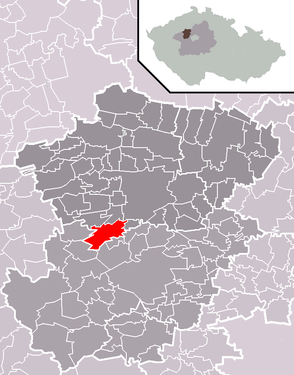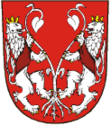Smečno
| Smečno | ||||
|---|---|---|---|---|
|
||||
| Basic data | ||||
| State : |
|
|||
| Region : | Středočeský kraj | |||
| District : | Kladno | |||
| Area : | 962 ha | |||
| Geographic location : | 50 ° 11 ' N , 14 ° 3' E | |||
| Height: | 372 m nm | |||
| Residents : | 1,962 (Jan 1, 2019) | |||
| Postal code : | 273 05 | |||
| License plate : | S. | |||
| traffic | ||||
| Street: | Slaný - Stochov | |||
| structure | ||||
| Status: | city | |||
| Districts: | 1 | |||
| administration | ||||
| Mayor : | Pavla Štrobachová (status: 2009) | |||
| Address: | náměstí TG Masaryka 12 273 05 Smečno |
|||
| Municipality number: | 532835 | |||
| Website : | www.smecno-mesto.cz | |||
| Location of Smečno in the Kladno district | ||||

|
||||
Smečno , until 1882 Muncifaj (German Smetschno , also Smeczno , Smeczna , formerly Munzifay , Muncifay ) is a city in the Czech Republic . It is located seven kilometers northwest of Kladno and belongs to the Okres Kladno .
geography
Smečno is located in the south-eastern foothills of the Džbán hill country. Road II / 236 between Slaný and Stochov runs through the village .
Neighboring towns are Přelíc in the north, Kvíc, Těhule and Hrdlív in the northeast, Třebichovice in the east, Vinařice in the southeast, Svinařov and Skalka in the south, Kačice and Obora in the southwest, Nová Ves in the west and Ledce and Šternberk in the northwest.
history
The first written mention of the Smečno Fortress took place in 1252 as the seat of Vladiken Bolezlav de Zmecen. In 1418 Markwart von Martinic acquired the Smečno fortress. His son Bořita had the fortress enlarged around 1460 and the St. Anne's Chapel built. After the death of the royal courtier Bořita von Martinic in 1479, the family named themselves Bořita von Martinic . By the beginning of the 16th century, the Bořita von Martinic family extended the rule to 17 villages. At the request of Hynek Bořita von Martinic, Wladislaw II Jagiello Smečno raised on May 26, 1510 to a media town that was named Muncifaj . On December 28, 1515, Vladislav II finally elevated Muncifaj to the city. Georg Bořita von Martinic began to convert the fortress into a renaissance castle in 1586, which was completed under his nephew Jaroslav Bořita von Martinic . Jaroslav successfully led his subjects back to Catholicism at the beginning of the 17th century. He was one of the most important Catholic politicians in Bohemia. After the Battle of White Mountain , Jaroslav Bořita managed to triple the territory of the Muncifaj rule. He was also raised to the rank of count. In 1711 the first potatoes imported into Bohemia were brought to Muncifaj for trial cultivation. In 1789 the male line of the Martinic counts died out , and in 1791 the goods belonged to the newly established Clam-Martinic count line . In 1815 Josef Božek presented his steam car in the castle park.
In 1848 Muncifaj became an independent town in the Slaný district. In 1882 it was officially renamed Smečno , as this name was more common among the population than the official name. At the instigation of the owner of Smečno, Heinrich Clam-Martinic , the narrow-gauge railway Slaný - Smečno - Kačice was built between 1903 and 1904 . After the concession was granted, public goods traffic was started in 1908 on the 15 km long route with 700 mm gauge. In 1911 two passenger cars were purchased, but they were only used for internal traffic in the rule. In 1913 Franz Ferdinand von Österreich-Este took the train to hunt in Studeněves . The property of Count Clam-Martinic was nationalized after the establishment of Czechoslovakia . After the nationalization of the railway, the passenger cars were used to transport officials of the Ministry of Railways during their inspections. The line was later used primarily as a beet railway and was discontinued in 1932.
Smečno has been part of the Okres Kladno since 1961 . The city center is protected as an urban conservation area.
City structure
No districts are shown for Smečno.
sons and daughters of the town
- Johann Prokop Mayer (1737–1804), pleasure gardener
- Zdeněk Liška (1922–1983), film composer
Attractions
- Smečno Castle, the renaissance building with the chapel of St. Anna emerged from a festival in 1586. It is used as a social welfare institution for women and is not accessible.
- Castle park, in the English landscape park is the baroque sala terrena built by Kilian Ignaz Dienzenhofer with a ceiling fresco by Jan Karel Kovář . The building is closed to the public because it is used as a welfare home for men.
- Church of St. Trinity, the building built for Georg Bořita von Martinic was consecrated in 1587, the Renaissance organ is the oldest functioning organ in Europe. It dates from 1620, its case from 1587.
- Trinity column, created in 1744 by Ignaz Franz Platzer
- Statue of St. Georg slaying a dragon, on the market, created in the 18th century
- Grave place of the Clam-Martinic family in the old cemetery
- Commemorative obelisk commemorating the re-Catholicization of the Smečno rule by Jaroslav Borsita von Martinic , erected at the beginning of the 17th century
- Military open air museum, the bunker of type 37 / B2-80z is one of the few remaining fortifications on the Prague line of the Czechoslovak Wall . It has been restored true to the original.
- Natural monument Smečenská rokle, the Plänerklamm is located southwest of the city
Individual evidence
- ↑ Český statistický úřad - The population of the Czech municipalities as of January 1, 2019 (PDF; 7.4 MiB)
- ↑ http://www.badatelna.cz/badatelna_detail.php?fond=64590


